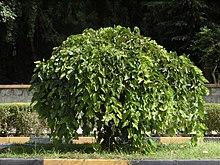Krishnasami Venkataraman
Krishnaswami Venkataraman | |
|---|---|
| Born | 7 June 1901 Baker-Venkataraman transformation |
| Relatives | K. Swaminathan (brother) Krishnaswami Srinivas Sanjivi (brother) Madhav Sharma (nephew) |
| Awards |
|
| Scientific career | |
| Fields | |
| Institutions | Robert Robinson |
| Doctoral students | |
Krishnaswami Venkataraman
Biography



Krishnaswami Venkataraman was born on 7 June 1901 in Madras (present-day
He studied chemistry at
On his return to India in 1927, he worked at the
Venkataraman married Shakunthala at the age of nineteen when his bride was only fourteen.
Scientific and professional contributions
One of the major scientific achievements of Venkataraman was his experiments with
Shortly after the
Another of Venkataraman's contributions was his work on
During his tenure at UDCT, Venkataraman was instrumental in starting several courses chemical technology, combining pure science and technology.[4] He guided around 85 students in their doctoral research which included such notable chemists as B. D. Tilak,[14][15] B. S. Joshi,[16] Nitya Anand and A. V. Rama Rao.[2][note 4] His contributions are reported in the development of National Chemical Laboratory into one of World's leading research centre in dyestuff chemistry.[9] He sat in the editorial boards of many journals, which included Tetrahedron, Tetrahedron Letters and Indian Journal of Chemistry. Besides The Chemistry of Synthetic Dyes, he also edited another 612-page book, The Analytical Chemistry of Synthetic Dyes[17] and these nine books remain reference texts in the discipline.[18] Besides, he also published 271 scientific articles.[19]
Venkataraman served as the president of the Indian Academy of Sciences for three terms (1943–46, 1949–55, 1965–67) and as the vice president from 1952 to 1955.[20] He also served as the vice president of the Indian National Science Academy.[9]
Awards
Venkataraman was elected a fellow of the
The Government of India awarded Venkataraman the third highest civilian award of the
Bibliography
- Krishnasami Venkataraman (1952). The Chemistry of Synthetic Dyes - Volume 1. Academic Press. ISBN 9780127170015.
- Krishnasami Venkataraman (1969). The chemistry of synthetic dyes - Volume II. Acad. Press. ISBN 9780127170022.
- Krishnasami Venkataraman (1978). The chemistry of synthetic dyes - Vol III. Academic Press. ISBN 9780127170046.
- K., Venkataraman (1971). The Chemistry of Synthetic Dyes Volume IV. Oxford: Elsevier Science. ISBN 9780323145701.
- The chemistry of synthetic dyes. Volume V. New York: Academic Press. 1971. ISBN 9780323142953.
- The chemistry of synthetic dyes Volume VI. New York: Academic Press. 1972. ISBN 9780323148597.
- Krishnasami Venkataraman (1974). The chemistry of synthetic dyes Volume VII. Academic Press. ISBN 978-0-12-717007-7.
- The Analytical chemistry of synthetic dyes. New York: Wiley. 1977. OCLC 2542360.
- The chemistry of synthetic dyes Volume VIII. New York: Academic Press. 1978. OCLC 849921776.
See also
Notes
- ^ Prior to 1970, the Indian National Science Academy was named the "National Institute of Sciences of India", and its fellows bore the post-nominal "FNI". The post-nominal became "FNA" in 1970 when the association adopted its present name.
References
- ^ a b "Padma Awards | Interactive Dashboard". www.dashboard-padmaawards.gov.in. Retrieved 18 July 2019.
- ^ a b c d e f g h i Anand, Nitya (22 May 2018). "Krishnaswami Venkataraman (1901–1981)" (PDF). Indian National Science Academy. Retrieved 22 May 2018.
- ^ "Visionary doctor's legacy". The Hindu. 28 March 2005. Retrieved 22 May 2018.[dead link]
- ^ a b c "Father of dyestuff research". The Hindu. Archived from the original on 17 May 2003. Retrieved 26 May 2017.
- ^ "ICT Mumbai". www.ictmumbai.edu.in. Retrieved 26 May 2017.
- ^ "CSIR- National Chemical Laboratory". www.ncl-india.org. Retrieved 26 May 2017.
- ^ "The last liberal". The Hindu. 4 November 2001. Archived from the original on 25 August 2002. Retrieved 22 May 2018.
- ^ "Obituary: Lovraj Kumar". The Independent. 1 April 1994. Retrieved 22 May 2018.
- ^ a b c d e f "INSA :: Deceased Fellow Detail". www.insaindia.res.in. 22 May 2018. Retrieved 22 May 2018.
- ISSN 0368-1769.
- ISSN 0021-9584.
- ISSN 0036-8075.
- ^ "Chemistry Tree - Krishnaswami Venkataraman". academictree.org. 22 May 2018. Retrieved 22 May 2018.
- ^ Panse, G.T. "Bal Dattatreya Tilak Obituary". Archived from the original on 25 February 2004. Retrieved 4 September 2014.
- ISBN 978-0-470-18816-3.
- ^ "B.S. Joshi's scientific contributions". ResearchGate. 22 May 2018. Retrieved 22 May 2018.
- OCLC 2542360.
- ISSN 0570-0833.
- ^ "Krishnaswami Venkataraman - NeglectedScience". www.neglectedscience.com. 22 May 2018. Retrieved 22 May 2018.
- ^ "Fellow profile - Indian Academy of Sciences". www.ias.ac.in. 22 May 2018. Retrieved 22 May 2018.
- .
- ^ "Fellowship - Indian Academy of Sciences". www.ias.ac.in. 22 May 2018. Retrieved 22 May 2018.
- ^ a b "INSA :: Biographical Memoirs". insaindia.res.in. Retrieved 26 May 2017.
- ^ "Mitgliederverzeichnis". www.leopoldina.org (in German). Retrieved 26 May 2017.
- ^ "INSA :: Awards Recipients". www.insaindia.res.in. 22 May 2018. Retrieved 22 May 2018.
Further reading
- Nagendrappa, G. (1 December 2004). "An epitome of K Venkataraman's chemistry" (PDF). Resonance. 9 (12): 45–51. S2CID 56234414.
- Nagendrappa, G. (1 December 2004). "K Venkataraman a biographical sketch". Resonance. 9 (12): 3–5. S2CID 123449690.
